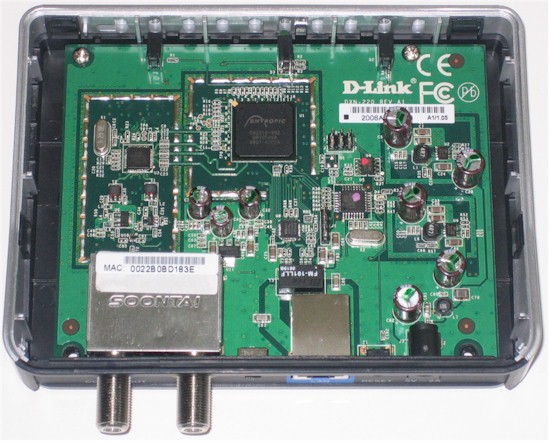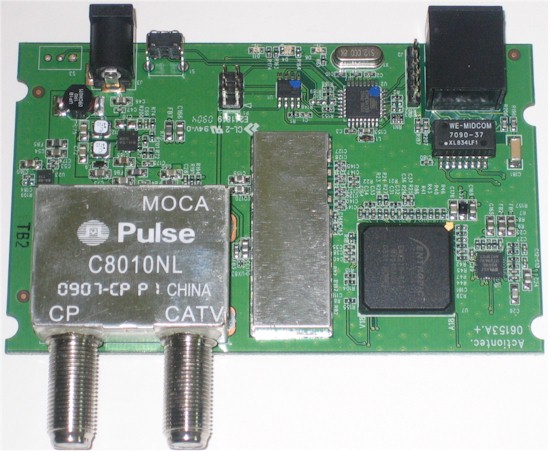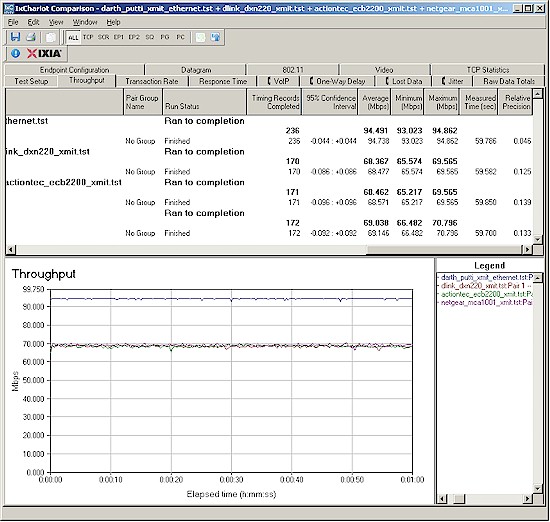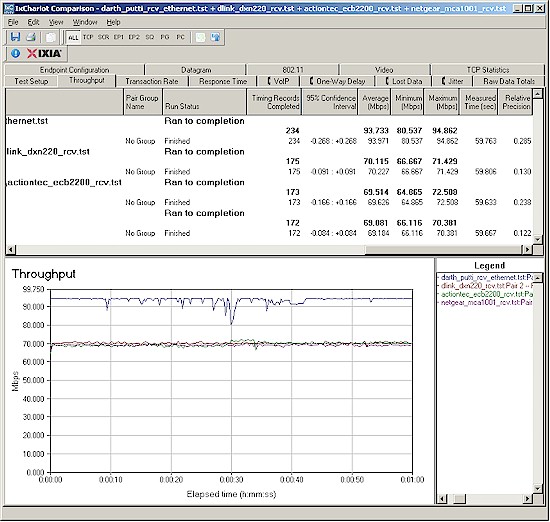Introduction
Updated 5/19/2009: Added performance data for multiple connections
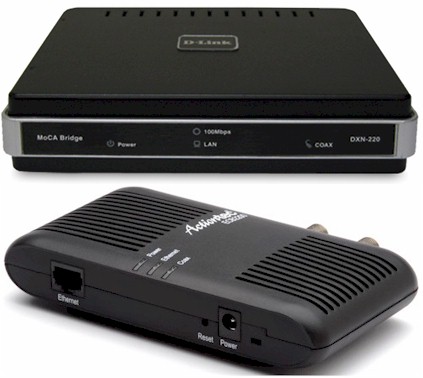
| At a Glance | |
|---|---|
| Product | D-Link HD MediaBridge Coax Network Starter Kit (DXN-221) Actiontec Ethernet over Coax MoCA Network Adapter (ECB2200) |
| Summary | Clones of the same Entropic reference design that extend 10/100 Ethernet via TV coax cabling |
| Pros | • ~70 Mbps maximum for a single TCP/IP stream • ~140 Mbps for multiple streams • Unaffected by RF and powerline noise • Low latency (ping time) |
| Cons | • ~70 Mbps maximum for a single TCP/IP stream • Doesn’t work with satellite TV • Doesn’t appear to prioritize media over data |
Since our review of NETGEAR’s MCAB1001 MoCA kit, two more makers have decided to make their MoCA adapters available to retail / etail buyers. D-Link reversed its earlier decision and is shipping the DXN-221 HD MediaBridge Coax Network Starter Kit. And Actiontec‘s ECB2200, which has been provided to Verizon for use with Actiontec’s MI424WR routers, appears to be available online through a few smaller etailers.
The NETGEAR review provides the background on MoCA, its advantages and its limitations, so I won’t repeat it here. I’ll just take a quick look at the hardware and then jump right to the test results.
Product Overviews
Figure 1 from the User manual shows the DXN-220’s (the individual adapter part number) front panel indicators, which are very similar to those on the NETGEAR.
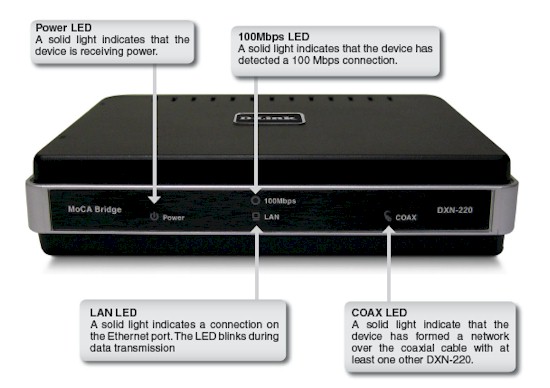
Figure 1: DXN-220 front panel
Figure 2 shows the D-Link’s rear panel—again, similar to the NETGEAR. Also as before, the Ethernet port is 10/100 and there is a switch to change between MoCA and Config modes. There is no button to douse the front panel lights, which isn’t a problem because they aren’t that annoying.
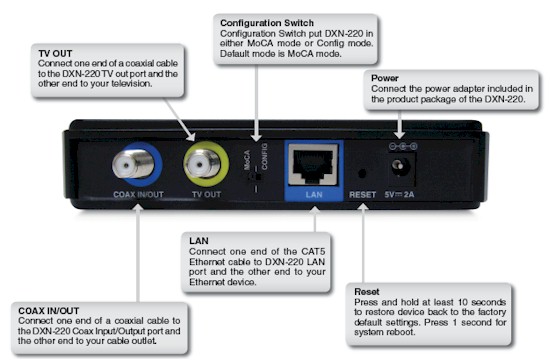
Figure 2: DXN-220 Rear Panel
Actiontec takes a very minimalist approach with the ECB2200, probably because it is designed for deployment by service providers. Big companies like Verizon don’t like customers playing with settings and causing service calls and possible truck rolls for repair. There is no way to put the adapter into Config mode and the adapter even ships with a cap over the STB/TV coax port to prevent misconnection.
You’ll also note by looking at Figure 3 and the opening photo above that connectors are placed on both the "front" and "back" of the device. I think the main reason for this was to make the board as small as possible, which saved on material cost. Power, Ethernet and Coax lights are on top of the unit, which I liked, since it makes them easy to see from above.
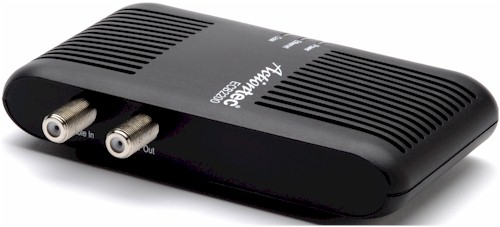
Figure 3: ECB2200 coax panel
The D-Link kit came with two adapters, Ethernet cables and small footprint wall-warts, but no coax jumpers like the NETGEAR kit included. There was also a printed Quick Install Guide and CD with PDF User manual and Utility program. Everything was packed in a plain brown box that obviously wasn’t designed for bricks-and-mortal retail, since it had no product image or information printed on it.
Actiontec put two ECB2200’s, two wall-warts and a single page Installation Guide into a plain white box for my review purposes. But note that the ECB2200 is sold individually and not in a kit. There were no Ethernet or coax cables and no CD or other documentation. I checked the Actiontec website for documentation, but found none there, either.
However, as with the NETGEAR product, all I had to do with both the D-Link and Actiontec products was connect power, coax and Ethernet cables and they linked right up with no futzing around required.
Inside View
Figures 4 and 5 are photos of the D-Link and Actiontec boards. Both are variations of what is probably an Entropic reference design and use the same components as the NETGEAR MCA1001, i.e. Entropic EN2210-BG2 c.Link Coaxial Network Controller, Entropic EN1010 RF Interace, Micrel KSZ8041NL 10/100 Ethernet PHY and Atmel ATMEGA168 AVR Microcontroller with 16 KB Flash, 1 KB RAM and 512 B EEPROM.
Figure 4: DXN-220 board
Note that the D-Link is the only design of the three to not have the Entropic EN1010 under an RF shield.
Figure 5: ECB2200 board
Administration
As noted above, the Actiontec adapter has no admin access and therefore nothing to tweak. This also means that you can’t set it into "All Pass" mode if you want to jump through the hoops required to get MoCA to work on a coax system that has satellite TV on it.
D-Link’s adapter, on the other hand, is just like NETGEAR’s and can be put into "Config" mode. On a hunch, I did just that, then fired up the NETGEAR MoCA utility that still was installed on one of my systems. Sure enough, it recognized the DXN-220 just fine and even allowed me to change settings.
The two utilities are organized a bit differently. But they both access the same configuration settings and display the same status information. Figure 6 is a screenshot of the D-Link utility’s Setup page. See the NETGEAR review is you want a walk-through of the other settings and status screens.
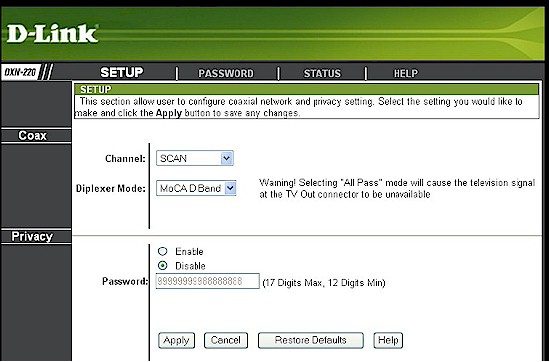
Figure 6: D-Link Utility
Performance
I skipped the step of doing a "Bench" test by connecting the two adapters via a short cable. Instead, I jumped right to the "in-house" test, because my previous testing showed no discernable difference between the two methods. The "in-house" test used the configuration shown in Figure 7 (copied from the NETGEAR review).
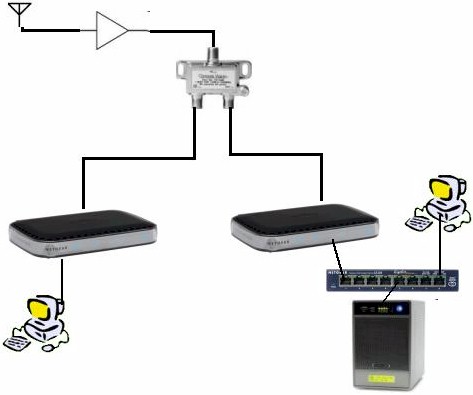
Figure 7: In-house MoCA test setup
Keep in mind that the only signal present on my home’s coax network is an OTA antenna signal to receive local HD broadcasts. I receive most of my programming via DirecTV. But those signals travel on their own coaxes
The antenna line runs from the attic, down to the basement, through a cheapo amplifier that came with the antenna, into my coax patch panel that then runs the signal up to an HD DVR in the living room. For the test setup, I added a two-output splitter that connected the antenna and amp to two coax lines that run to my lab and office.
Each of the runs from splitter to MCA has around 50 feet of RG6 coax. Ignore the NETGEAR ReadyNAS in Figure 7. It was used in the previous review to perform HD viewing tests. But I also skipped those this time around, once I saw the results from the IxChariot plots.
I then ran a series of IxChariot tests using the throughput.scr, TCP/IP and changing only the test file size from its default of 100000 to 3000000 Bytes. I also ran reference tests using a 10/100 Ethernet connection between the two test machines.
Figure 8 compares transmit throughput using 100 Mbps Ethernet, a pair of DXN-220’s, a pair of ECB2200’s and a pair of NETGEAR MCA1001’s between the two test endpoint computers. The three pair of MoCA adapters behave, for all intents and purposes, identically, producing just shy of 70 Mbps of nice, steady throughput. Note that this is around 25 Mbps less than produced by the 100 Mbps Ethernet connection.
Figure 8: MoCA transmit throughput comparison
Figure 9 compares the receive results, which look essentially the same.
Figure 9: MoCA receive throughput comparison
Updated 5/19/2009: Added performance data for multiple connections
A helpful reader pointed out that I didn’t include maximum throughput information, so here it is. Just as with single-connection speed, multiple connection thoughput peaked with four simultaneous connections. The DXN-220 had a maximum aggregate throughput just shy of 139 Mbps (IxChariot plot), while the ECB2200 peaked at only 130 Mbps (IxChariot plot). I suspect the difference is due to different defaults in the Actiontec device that are optimized for its target service provider.
Closing Thoughts.
As I said, once I saw the test results, test time was over. With the same Entropic chipset with pretty much the same design and the nice, controlled impedance, noise-free environment of coax cabling, these three MoCA adapters will all provide the same performance.
So feel free to buy based on price and brand preference. I’d stick with the D-Link and NETGEAR products, however. Actiontec doesn’t really seem interested in getting the product to many etailers. And the lowest price that I saw among the few that are carrying the ECB2200 was $135…each!
It will pay to shop around for the D-Link and NETGEAR kits, since Google Shopping showed the D-Link DXN-221 kit as low as $157 (but out of stock) and the NETGEAR MCAB1001 at $171 (but in stock).

